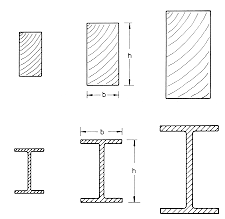|
The
material type may influence the shapes that can be achieved. For the wood
shown at the top of the diagram, stronger beams are fabricated from larger
cross-sections. The aspect ratio (h/b) can be changed to improve deflection
response for a beam loaded in the "h" direction and the 2 x 4, 2 x 6, and
2 x 10, sections common for house construction rely on this change of depth
to permit larger loads to be carried. The steel sections shown in the lower
part of the diagram take advantage of the same geometrical behavior, the
deeper section having a larger resistance to bending than the smaller section.
The rolling technique used to form steel into beams permits the more complicated
shape. In this case, the material section thickness, t, is important as
well as the overall aspect ratio.
A
"shape factor" can be associated with each of these section types that
will give information about their performance in elastic bending or torsional
deflection. For each of the sections shown the shape factor is the same
for each member of the group since each is a scaled version of the basic
section. For the rectangular section, the shape factor for bending,
fB
= 2,
and for the I-beam sections
fB
= 10.
Using these shapes fabricated from different materials will not alter their
shape factor but will change their response to a given load. |
|
|
|
|
|
|
|
|
|
|
